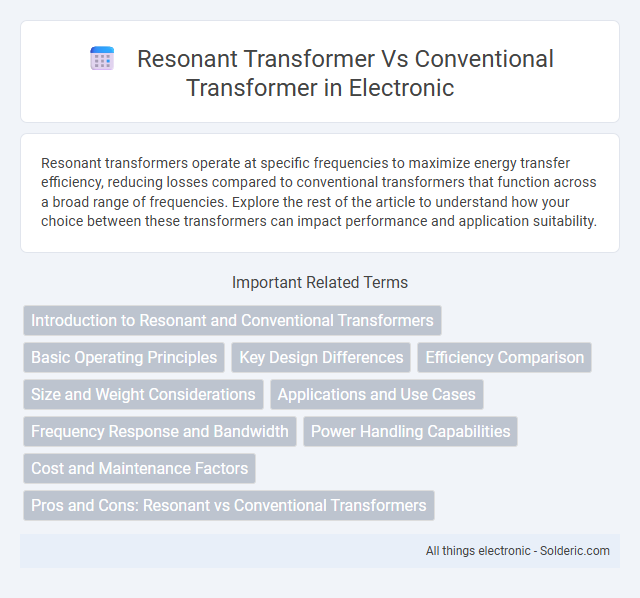Resonant transformers operate at specific frequencies to maximize energy transfer efficiency, reducing losses compared to conventional transformers that function across a broad range of frequencies. Explore the rest of the article to understand how your choice between these transformers can impact performance and application suitability.
Comparison Table
| Feature | Resonant Transformer | Conventional Transformer |
|---|---|---|
| Operating Principle | Uses resonant frequency to transfer energy efficiently | Transfers energy via magnetic induction without resonance |
| Efficiency | Higher efficiency at resonant frequency | Moderate efficiency depending on load and design |
| Frequency | Operates at specific resonant frequency (kHz to MHz) | Usually operates at power grid frequency (50/60 Hz) |
| Size & Weight | Smaller and lighter due to high-frequency operation | Larger and heavier due to low-frequency core design |
| Applications | Wireless power transfer, induction heating, RFID | Power distribution, voltage regulation, signal isolation |
| Complexity | More complex design and tuning required | Simple, robust, and widely used design |
| Cost | Higher initial cost due to specialized components | Lower cost, mass-produced |
Introduction to Resonant and Conventional Transformers
Resonant transformers utilize LC circuits to achieve efficient energy transfer at specific frequencies, reducing losses and improving voltage regulation compared to conventional transformers. Conventional transformers function on Faraday's law with fixed windings and core materials, suitable for broad frequency ranges but often less efficient at high frequencies. Understanding Your application's frequency and efficiency requirements helps determine the appropriate transformer type.
Basic Operating Principles
Resonant transformers operate by utilizing a resonant circuit, where inductors and capacitors create oscillations at a specific frequency, enabling efficient energy transfer with minimal losses. Conventional transformers rely on magnetic induction between primary and secondary coils to transfer power, with energy losses primarily due to core hysteresis and winding resistance. Understanding your application's frequency and efficiency requirements helps determine whether a resonant or conventional transformer best suits your needs.
Key Design Differences
Resonant transformers utilize a tuned LC circuit to achieve efficient energy transfer at a specific resonant frequency, reducing losses and improving voltage regulation compared to conventional transformers. Their design incorporates capacitors to create resonance, enabling higher efficiency in high-frequency applications, whereas conventional transformers rely solely on magnetic coupling with fixed inductance and core materials. Your choice depends on application needs, with resonant transformers excelling in wireless power transfer and high-frequency circuits, while conventional transformers suit general power distribution.
Efficiency Comparison
Resonant transformers typically achieve higher efficiency than conventional transformers by minimizing core and copper losses through resonant frequency operation, which reduces energy dissipation. The ability to operate at higher frequencies allows resonant transformers to utilize smaller, lighter components while maintaining power transfer with lower heat generation. Your choice of a resonant transformer can lead to significant energy savings in applications where efficiency and reduced power loss are critical.
Size and Weight Considerations
Resonant transformers generally exhibit smaller size and reduced weight compared to conventional transformers due to their ability to operate efficiently at higher frequencies, which allows for the use of smaller magnetic cores and fewer turns of wire. Conventional transformers rely on lower frequencies, necessitating larger cores and heavier materials to handle equivalent power levels. This size and weight reduction makes resonant transformers particularly suitable for compact, portable, and weight-sensitive applications.
Applications and Use Cases
Resonant transformers are widely used in wireless power transfer, induction heating, and radio frequency applications due to their ability to efficiently operate at specific resonance frequencies, minimizing energy loss. Conventional transformers are commonly utilized in power distribution, voltage stepping, and electrical isolation in industrial, commercial, and residential settings because of their robust design and ability to handle a wide range of frequencies and power levels. The choice between resonant and conventional transformers depends on the application requirements for efficiency, frequency, and load conditions.
Frequency Response and Bandwidth
Resonant transformers exhibit a narrow frequency response and high selectivity due to their operation at a specific resonant frequency, allowing them to efficiently transfer energy within a limited bandwidth. Conventional transformers have a broader frequency response and wider bandwidth, making them suitable for a range of frequencies but with lower efficiency at high frequencies. Your choice depends on whether you need precise frequency tuning or versatile frequency handling.
Power Handling Capabilities
Resonant transformers handle power more efficiently by minimizing core losses and reducing heat generation through resonant frequency operation, enabling higher power transfer with reduced stress on components. Conventional transformers typically experience greater energy dissipation and thermal constraints, limiting their power handling capacity compared to resonant designs. Your choice depends on the required power efficiency and thermal management in high-frequency or high-power applications.
Cost and Maintenance Factors
Resonant transformers typically have higher initial costs due to their advanced components and design complexity compared to conventional transformers. Your maintenance expenses can be lower with resonant transformers as they operate more efficiently, reducing heat generation and component stress, which extends their lifespan. Conventional transformers often require more frequent inspections and repairs, increasing long-term maintenance costs despite their lower upfront investment.
Pros and Cons: Resonant vs Conventional Transformers
Resonant transformers offer higher efficiency and lower electromagnetic interference due to their ability to operate at resonant frequencies, making them ideal for high-frequency applications and wireless power transfer. Conventional transformers provide robust performance with simpler design and cost-effectiveness, but they suffer from higher core losses and reduced efficiency at high frequencies. While resonant transformers demand precise tuning and complex circuitry, conventional transformers are more reliable and easier to maintain in standard power distribution systems.
resonant transformer vs conventional transformer Infographic

 solderic.com
solderic.com